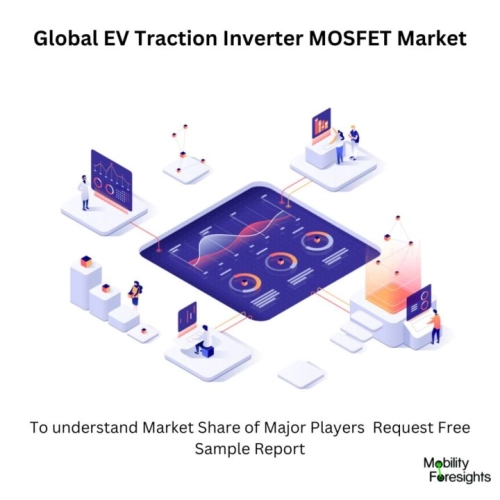
- Get in Touch with Us

Last Updated: Apr 25, 2025 | Study Period:
The global EV traction inverter MOSFET market is undergoing rapid growth as electric vehicle adoption surges worldwide. This is primarily driven by advancements in semiconductor technology, enabling higher efficiency and power density in traction inverters. MOSFETs (Metal-Oxide-Semiconductor Field-Effect Transistors) play a critical role in controlling the electric motor, and their technological progress is pivotal in extending the driving range of EVs and improving performance. Governments worldwide are promoting EVs through incentives and regulations, further fueling the demand for high-performance MOSFETs in traction inverters.
Technology is a key factor transforming the market, particularly with the adoption of Silicon Carbide (SiC) MOSFETs, which offer superior performance in high-power applications. These innovations allow for more compact and efficient inverter designs, reducing system losses and improving vehicle efficiency. However, high manufacturing costs and the complexity of SiC technology present ongoing challenges. The market also faces headwinds from the global semiconductor shortage, which has slowed the production of critical components.
The global EV traction inverter MOSFET market represents a crucial segment of the electric vehicle ecosystem, with MOSFETs playing a vital role in converting electrical energy into mechanical energy within the drivetrain. This market encompasses various models of MOSFETs, from traditional silicon-based technologies to more advanced Silicon Carbide (SiC) variants.
Different types of MOSFETs serve varying functions within electric vehicles. While traditional silicon-based MOSFETs remain prevalent, SiC MOSFETs are gaining popularity due to their higher efficiency, enabling faster switching speeds and better thermal management. These types cater to different vehicle segments, from compact EVs to high-performance models.
The applications of MOSFETs are primarily found in the powertrain of EVs, where they help optimize energy usage in electric motors. They are also used in battery management systems, inverters, and charging systems, enabling faster charging and better energy recovery during braking.
While MOSFETs offer significant benefits in improving efficiency and reducing heat generation, challenges such as high manufacturing costs and technical complexity persist. These challenges limit widespread adoption, especially in lower-cost EVs. However, ongoing R&D efforts aim to address these issues.
As of 2023, the global EV traction inverter MOSFET market is valued at USD 1.2 billion and is expected to grow at a CAGR of 12.5%, reaching USD 3.5 billion by 2030. This growth is largely driven by the increasing penetration of electric vehicles, especially in Europe, China, and the U.S. The transition toward SiC MOSFETs, which offer better performance in high-power applications, is expected to play a significant role in this growth trajectory.

Key drivers behind this expansion include the rise in government incentives for EV adoption and advancements in power electronics technology. The market's future growth is also fueled by continued investments in R&D aimed at reducing the costs of SiC MOSFETs and improving their overall performance.
By Technology:
By Voltage:
By Application:
By Region:
| SI No. | Topic |
| 1 | Market Overview |
| 2 | Scope of the Report |
| 3 | Research Methodology |
| 4 | Executive Summary |
| 5 | Key Findings |
| 6 | Global Ultra-Low-Power RF Transceiver Market Production Footprint - 2023 |
| 7 | Technological Developments in Ultra-Low-Power RF Transceivers |
| 8 | New Product Development in Global Ultra-Low-Power RF Transceiver Market |
| 9 | Regulations, Standards, and Interoperability Challenges |
| 10 | Major Projects Utilizing Ultra-Low-Power RF Technology |
| 11 | Market Size, Dynamics, and Forecast, by Region, 2024-2030 |
| 12 | Market Size, Dynamics, and Forecast, by Product Type, 2024-2030 |
| 13 | Market Size, Dynamics, and Forecast, by Application, 2024-2030 |
| 14 | Market Size, Dynamics, and Forecast, by Frequency Band, 2024-2030 |
| 15 | Competitive Landscape |
| 16 | Leading Players Analysis |
| 17 | Market Share of Vendors, 2023 |
| 18 | Company Profiles |
| 19 | Unmet Needs and Opportunities in Ultra-Low-Power RF Transceivers |
| 20 | Industry Adoption of Ultra-Low-Power RF Transceivers |
| 21 | Investment Opportunities in Ultra-Low-Power RF Transceiver Market |
| 22 | Government Initiatives and Their Impact on Ultra-Low-Power RF Adoption |
| 23 | Conclusion |